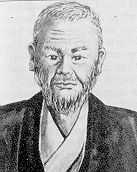
Master Ankoh Itosu's Precepts
(10 Rules of Karate Practice)
October, 1908
In 1901 Ankoh Itosu sensei introduced Okinawan Karate into the Shuri Elementary School System as part of the physical education training program. This became the root by which Okinawan Karate began to gain popularity. By 1905 Itosu sensei was teaching Okinawan Karate at the Dai Ichi College and the Teacher's Training College. In 1908 he wrote a letter to the Prefectural Educational Department encouraging the introduction of Karate to all Okinawan schools including those on the Japanese mainland.
He wrote (paraphrased):
- Karate practice should be used as a means of self-defense and in order to protect one's parents and loved ones. It should be used to improve your health and should not be used for your own selfish interests or to deliberately hurt someone.
- The purpose of Karate is to train the human body to become as hard as rock and as strong as iron (steel). To effectively develop the hands and feet to be used as spears or arrows, and to develop a strong spirit and brave heart through continuous practice. If Karate were introduced at the elementary school level, the children would be well prepared for the military in the future. Both the First Duke of Wellington and Napoleon I discussed the concept of "tomorrow's victory can come from today's playgrounds".
- Karate is not learned over a brief period of time. To understand Karate more fully, one should practice seriously everyday for at least three or four years.
- In Karate the hands and feet should be trained on the 'makiwara' by striking it about one or two hundred times. This can be achieved by dropping or relaxing (without tension) the shoulders. Open your lungs (inhale deeply) without raising the shoulders, take hold of your strength (hold your breath briefly), grip the ground with your feet and sink your intrinsic energy (Ki, Chi, Internal Life Force) to your lower abdomen
(Tanden).
- Karate should be practiced with the proper stances executed by keeping the back straight, lowering the shoulders, allowing the strength to develop in the legs, positioning the feet firmly on the ground and delivering the Ki through the tanden, while keeping the upper and lower parts connected throughout the movement.
- Karate techniques should be practiced repeatedly over and over a great number of times. The correct explanation (Bunkai) of the techniques should be learned and then properly applied to the given circumstances.
- Karate practitioners should decide whether the emphasis is on purely physical fitness training or only the practical use of the body.
- Karate should be practiced with great intensity and the concept of always being prepared to defend your self, as if on the field of battle.
- Karate should be practiced correctly and to develop the proper strength of technique. Do not over exert your self or over do it.
- Those who have previously mastered Karate have lived to an old age. This was achieved because Karate helps in the development of muscles and bones, helps the digestive organs, and improves the circulation of blood. Therefore, Karate should be introduced into the physical education classes and practiced from the elementary school level onwards.
References/Bibliography
McCarthy Patrick. Classical Kata of Okinawan Karate. Burbank, California: Ohara Publications, Inc.,
1987.
Bishop Mark. Okinawan Karate, Teachers, Style and Secret Techniques. London, Great
Britian: A & C Black (publishers) Ltd., 1989.
Hargrove Frank. The 100 year History of Shorin-ryu Karate. U.S.A. : Fadorah Publishing Co., 1986.
Alexander George w. Okinawa Island of Karate. West Palm Beach, Florida: Yamazato Publications, 1991.